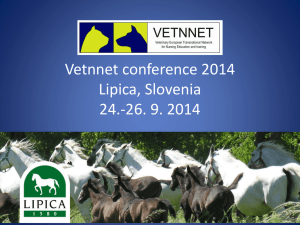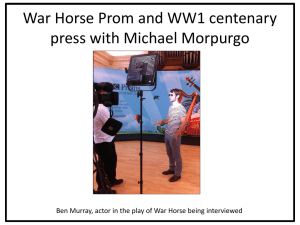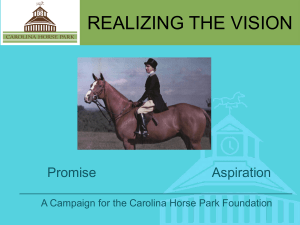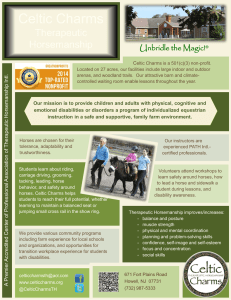Equine Behavior-Psychology of Training
advertisement
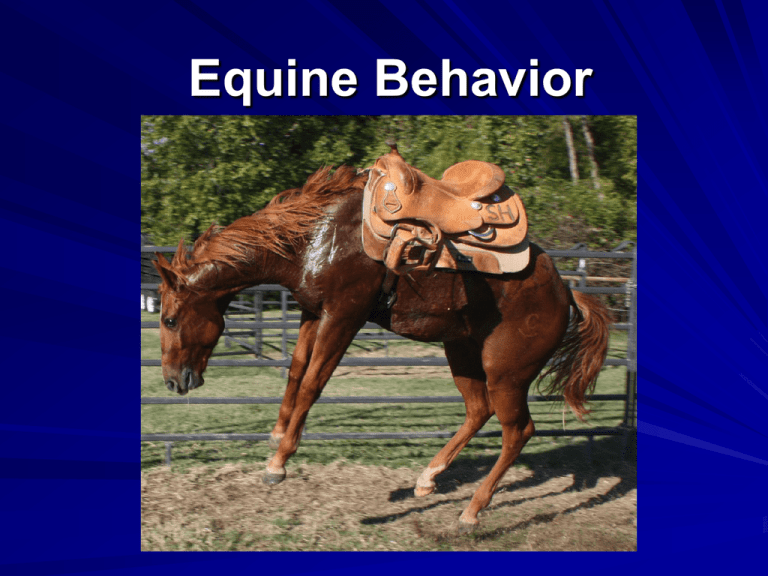
Equine Behavior Equine Behavior Why is it important to understand? – So communication can take place – So safety can be maintained – So training can occur Equine Behavior What types of behaviors do horses typically display? – Fight or Flight? – Creatures of Habit? – Creatures of Laziness? Would it be beneficial to understand these behaviors when attempting to train? Equine Behavior What is a horseman? What is horsemanship? – The ability to effectively communicate with your horse according to the work at which you desire to achieve When does horsemanship start? When does it end? Normal Behavior Agonistic Behavior (Includes All): – Aggressive and conflict-related actions Fighting Submission Escape attempts Dominance hierarchy Stallions do not normally submit to dominance easily – May fight to the death if in small pastures Normal Behavior Agonistic Behavior: – One must manage horses according to: Dominance Submission in the herd – Many horses are dominant, but not aggressive Rule by means of Pinned ears Threatening gestures Intimidating charges Agonistic Behavior Normal Behavior Sexual Behavior: Fillies reach puberty when? – ~20 months of age – Estrus: Frequent urination in the presence of a stallion, squatting, standing, squealing – Di-estrus: Unwilling to stand for male, possibly aggressive towards male Normal Behavior Sexual Behavior: Intact males reach puberty much younger than fillies (Upon puberty): – Become more aggressive – May paw ground, kick, squeal – Display Flehman response Geldings are typically not sexually aggressive, but some may be Normal Behavior Epimeletic Behavior: – The concern of one animal for another animal’s needs – Examples: Mares care for their foals and will fight other horses to protect them Horses that do not associate much may stand head to tail during fly season Stallions seldom exhibit epimeletic behavior Normal Behavior Et-Epimeletic Behavior: – Involves signaling for care and attention – Examples: Weanlings call for their dams when separated Recognize a pickup truck that feeds them and will meet it regularly at an appointed time Pair Bonding: when separated they may call each other Normal Behavior Ingestive Behavior: – The stomach of a horse is small – Therefore they prefer to eat often and in small amounts – Like to cover ground while grazing Normal Behavior Eliminative Behavior: – Where and when they urinate and/or defecate Horses many times will wait until they get back to their stalls to urinate. Why? Habit? – Usually only opportunity at horse show – Raised in pasture Normal Behavior Eliminative Behavior: – Stallions will often defecate outside the stall in the same spot every day – Grazing mares and geldings on good size pastures will generally defecate and urinate at will – In crowded pastures two spots may be found Maybe a form of natural parasite management Eliminative Behavior Normal Behavior Investigative Behavior: – Curious and constantly investigating their surroundings – They frequently find an open bend, gate, or other things to meddle with – May also use the senses of touch, hearing, and smell to Identify aspects of their surroundings their inadequate eyesight has not clarified Abnormal Behavior Any difficult maneuver that is required of a horse by a human is – “Abnormal” behavior from the horse’s point of view Horses are asked to adapt Level of willingness is attributed to – Their flexibility and to their trainers’ skills Abnormal Behavior Some are able to adapt and some are not We attribute level of intelligence with? – Level of adaptability When horses are faced with abnormal conditions, they are exposed to: – Conflict – Uncertainty – Restriction Abnormal Behavior Conflict: – Mental conflict result from two opposing urges, both of which are equally strong – Example: Young horses being exposed to work they are unfamiliar with and expected to perform the task at a high level This creates anxiousness to avoid the work and possibly creating difficult situations Abnormal Behavior Uncertainty: – Horses exhibit abnormal behavior when faced with problems beyond their power of resolution – Example: Rider becomes angry and spurs the horse forward then jerks on the reins; may create buck or rear Abnormal Behavior Uncertainty: – A good trainer must not only know how to ask for the desired response – But must also be sensitive enough to know when a poor response is the result of confusion rather than resistance on the horse’s part – Too much uncertainty will result in what? Timid, hostile horses Abnormal Behavior Restriction: – Horses build a mental defense for restrictive conditions and relieve anxiety or boredom by abnormal behavior Example: – The unexercised confined horse develops stable vices that may continue when activities are increased or when boredom ceases Abnormal Behavior Restriction: – Examples? Cribbing, weaving, stall-walking, kicking, pawing, and eating bedding is a few Almost all of these are – Management-induced Cribbing Weaving Psychology and Training Psychology of Training The value of a horse is determined by what? – Largely by how much training has taken place Horse training deals with what? – The modification of behavior When training begins – Up to the trainer to decide the best method to achieve a specific goal Psychology of Training Does genetics play a role in training? – – – – – – Suitability to purpose Learning ability Growth potential Speed Strength Athleticism, etc. Psychology of Training To modify behavior, the trainer has to manipulate the horses what? – Environment The environment will be divided into: – Stimuli – Reinforcement Will be used relative to the response he/she desires Psychology of Training What are the fundamentals to the psychology of training? – Responses – Stimuli – Reinforcement The aspiring trainer must – Develop a clear understanding of each Responses Refers to the acts or movements which the horse makes Training involves – Teaching the horse to make the desired response Major responses such as – Stopping and jumping are the result of many minor responses Stimuli Divided into: – Conditioned and unconditioned categories Depends on their natural effect on the horse – What is an unconditioned response? A natural response with no practice – What is a conditioned response? Learned through practice – Considered a conditioned stimulus – Known as cues Basic Cues Since cues must be learned, where does the trainer start? – With those basic cues that are the closest to being natural – Example: Direct rein pressure If these obvious cues were all the horse ever acquired, would he be considered a very highly trained horse? Presenting New Cues Using the basic cues – Trainer will advance to more advanced cues – Pairing the new cue with the more basic in a daily training routine – New cue should always be presented first Presenting Specific Cues Best communication with horse seems to be through what? – Touch and Hearing Common stimuli (cues) used in training are voice commands and pressures – Examples: nose, mouth, neck, ribs, etc. – Some research states that horses make greater use of hearing than touch or sight Presenting Specific Cues Indiscriminate presentation of cues only confuses the horse Cues must be specific so that – Horse can identify them and separate them from outlying factors Good horsemanship is a must!!! Reinforcement Certain events are capable of strengthening responses to certain stimuli It is doubtful that any learning can be accomplished without – Reinforcement Can be divided into – Primary and secondary Reinforcement Primary reinforcers have natural reinforcing properties – Examples: – Feed Can be used as reward and can strengthen certain behavior Reinforcement Secondary reinforcers are – Acquired over a period of time – Can be said that they are learned Learning that the training period will end if he performs well is – Secondary reinforcement for the horse Stacy Westfall

